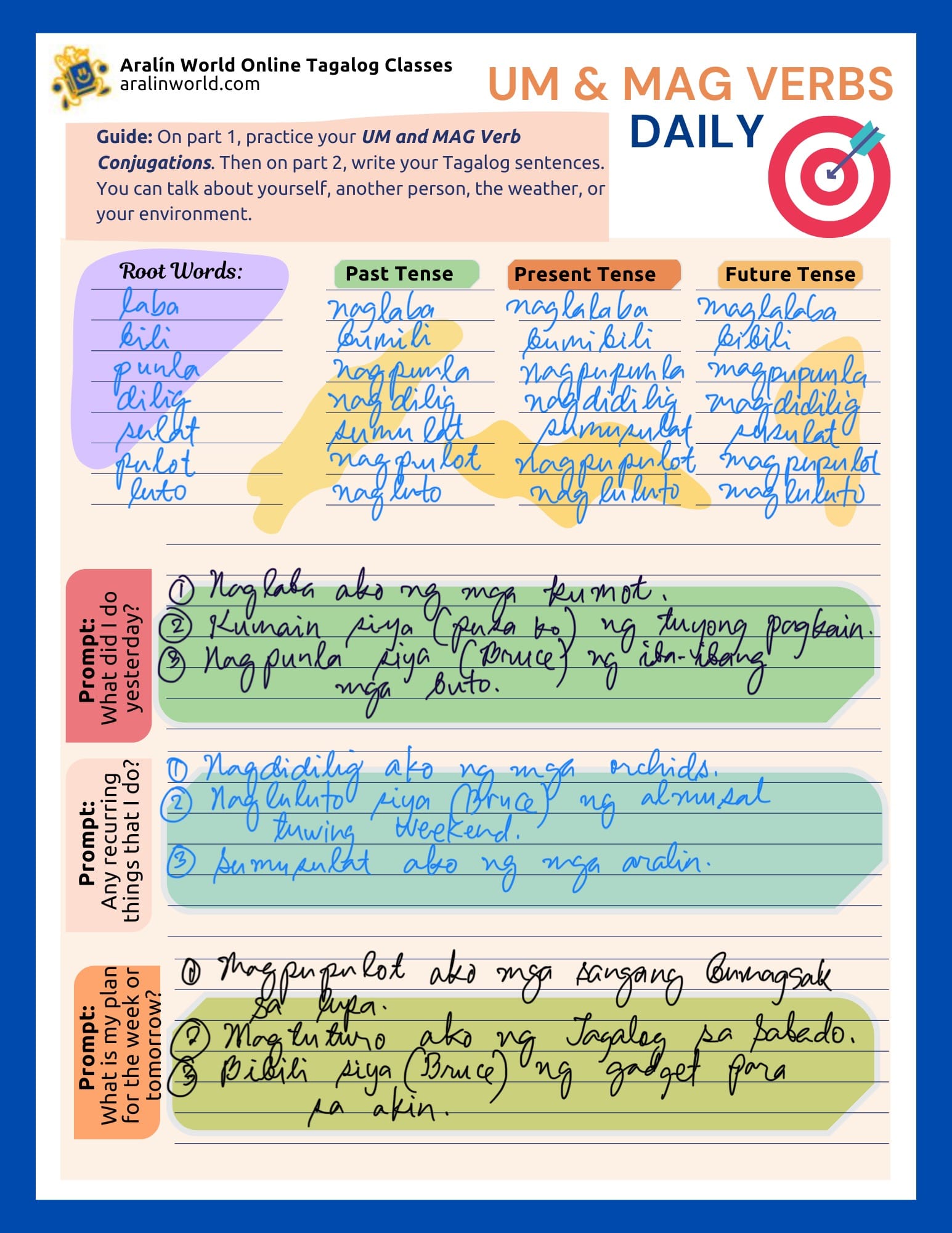How To Use Pronouns With MAG And UM Verbs: Learn Tagalog Verbs
Master Tagalog pronouns for MAG and UM verbs! Learn how to correctly pair pronouns with verbs in different tenses, with clear examples and a short quiz.

In Tagalog, verb conjugation is closely linked to pronouns, as they indicate who is performing the action. Different types of verbs, such as MAG and UM verbs, follow distinct patterns but share common pronoun usage. This tutorial will guide you on which pronouns to pair with these verbs to form correct sentences.
Objectives
At the end of this tutorial, you will be able to:
- Learn about Subjective Pronouns in Tagalog language.
- Construct simple sentences with verbs in an active voice.
- Use the right pronoun together with a MAG or Um verb.
Overview Of Tagalog Pronouns
The Tagalog pronouns can be grouped into various ways. First, a pronoun can be either subjective or objective. Second, it can either be singular or plural, and third, could be grouped according to the speaker's perspective.
A subjective pronoun, as the name suggests, is used as the subject of the statement. When you compose a statement, whether in your primary language or Tagalog, the subject always exists. A subject answers the question "What are you talking about?".
An objective pronoun, on the other hand, does not take the subject placement in the sentence. In Tagalog sentence structure, the objective pronoun plays a tricky part and it can be confusing to English speakers. Tricky because this type of pronoun can function as a possessive pronoun while other times it is paired with a verb expressed in passive voice which functions as the doer but not the subject of the statement.
In this tutorial, I will not give you an in-depth discussion on objective pronouns but I would rather focus on subjective pronouns. That is because both MAG and UM verbs are always expressed in active voice, and they simply require subject pronouns as the doer of the action.
Here’s the complete list of subjective pronouns:
- Ako (I, me)
- Tayo (We/us, inclusive)
- Kamí (We/us, exclusive)
- Ikaw (You, singular)
- Ka (You, singular)
- Kayó (You, plural)
- Siyá (He/she)
- Silá (They)
Notice that akó, ikáw, ka, and siyá are a group of singular subjective pronouns while tayo, kamí, kayó, and silá belong to the plural group.
Pronouns, From the Perspective of the Speaker
As far as the speaker's perspective is concerned, pronouns are grouped into three:
- The first person pronoun includes akó, tayo, and kamí. This means the speaker is the doer or part of the doer of the action.
- Pronouns that belong to the second person are ikáw, ka, and kayó. Using this group of pronouns means the speaker is not the doer of the action. The speaker implies that the second party is/are the doer of the action. The second party is usually the listener or the recipient of the message.
- The pronouns siyá and silá belong to the third person pronoun. From the speaker's perspective, the subject siyá or silá is not present in the conversation but at the same time, the 3rd person pronoun is the doer of the action.
Verb-Pronoun Agreement
Composing a Tagalog sentence requires a careful decision on which verb group to use along with its doer pronoun. Today, we will focus on the two verb groups: MAG verbs and UM verbs.
MAG and UM verbs are expressed in active voice. A verb is in active voice if the subject is the doer of the action. That is why both MAG and UM verbs require a subjective pronoun as the subject of the statement.
Here are some example sentences with verbs paired with subjective pronouns:
| Example Sentences | English | Remarks |
|---|---|---|
| Uminóm akó ng kapé. | Drunk I ng coffee "I drank coffee." |
Uminóm is the past tense of the verb and it is in the same form as its infinitive mood: uminóm (to drink). The doer is akó while at the same time, akó is the subject of the statement. |
| Kakain tayo sa labás. | Will-eat we sa outside "We will eat outside." (includes you) |
Kakain is the future tense of the verb kumain (to eat). The doer is tayo while at the same time, tayo is the subject of the statement. |
| Magbasá ka ng balità. | Read you ng news "You read the news." (singular you) |
Magbasá is in an imperative mood while at the same time, magbasá is the infinitive form (to read). The doer is ka while at the same time, ka is the subject of the statement. |
| Sasama kayó sa amin. | Will come with you sa ours "You will come with us." (plural you) |
Sasama is the future tense of the verb sumama (to come with). The doer is ka while at the same time, ka is the subject of the statement. |
| Naglalarô silá ng chess. | Playing they ng chess "They are playing chess." |
Naglalarô is the present tense of the verb maglarô (to play). The doer is silá while at the same time, silá is the subject of the statement. |
| Umaawit siyá ng Ingles na awit. | Singing he/she ng English song "He/she is singing an English song." |
Umaawit is the present tense of the verb umawit (to sing). The doer is siyá while at the same time, siyá is the subject of the statement. |

How do you keep on top of your Tagalog verb vocabulary? Good news! I've prepared a blank template for you, as seen in the image above. Download the pdf copy of this tutorial and grab the blank worksheets so you can print as many copies as you want. Find the download link at the end of the Quizzes section.
Pronouns Ka and Ikáw, What’s the Difference?
While ka and ikáw both translate to “you” in English, they have distinct placements in a Tagalog sentence. Both are subjective pronouns, however if the verb is mentioned prior to the pronoun, like the sentences given above, ka is the right pronoun. Never replace ikaw with ka in such sentence structure.
While ikáw can be paired with any of the verbs from either MAG or UM group as its subjective pronoun, I would write a separate tutorial on this targeting an audience with advanced skill in Tagalog. For beginners in Tagalog, I would prepare another tutorial covering adjectives paired with ikáw.
Quiz 1
Instruction: Given the base form of the verb, fill in the blank with future tense of the same verb.
| Infinitive Verbs | Your Sentences |
|---|---|
| Kumuha (to get) |
1. __________________ kayó ng kanin mamayâ. (You will get rice later.) |
| Magsabi (to tell) |
2. __________________ tayo nang totoó. (We will tell the truth.) |
| Mag-asawa (to get married) |
3. __________________ akó pagkatapos ng dalawáng taón. (I will get married in two years.) |
| Uminóm (to drink) |
4. __________________ silá ng alak mamayáng gabi. (They will drink liquor/wine tonight.) |
| Magtaním (to plant) |
5. __________________ kamí ng maís sa susunod na buwán. (We will plant corn next month.) |
Quiz 2
Instruction: Given the pronoun hints in the first column, fill in the blank with the right pronoun.
| Pronoun Hints | Your Sentences |
|---|---|
| 3rd person plural | 1. Bumalík ___________ sa tindahan. (bumalík: went back; tindahan: store) |
| 1st person plural, exclu | 2. Mag-aaral ___________ ng martial arts. (mag-aaral: will study) |
| 1st person plural, inclu | 1. Lumangóy ___________ kahapon. (lumangóy: went back; kahapon: yesterday) |
Quiz 3
Instruction: Given the verb roots, pronoun hints, and simple phrases as additional information, construct your sentences in Tagalog. Use space provided to write your answers.
| Verb Root | Pronoun Hints | Additional Information | Your Sentences |
|---|---|---|---|
| Alís (leave) |
3rd person singular |
dito kahapon (here yesterday) |
Example: Umalís siyá dito kahapon. |
| Datíng (arrive) |
2nd person plural |
dito bukas (here tomorrow) |
1. |
| Prito (fry) |
1st person singular |
ng itlóg ngayón (ng egg now) |
2. |
| Pasok (enter) |
3rd person plural |
sa hotél kagabí (sa hotel last night) |
3. |
| Usap (talk) |
1st person plural, inclu |
ngayón (now) |
4. |
| Bilí (buy) |
2nd person singular |
ng tinapay mamayâ (ng bread later) |
5. |
| Bilí (buy) |
3rd person plural |
ng gatas kanina (ng milk earlier) |
6. |
| Labás (go out) |
1st person plural, exclu |
sa simbahan ngayón (sa church now) |
7. |
Download this Workbook
🤔 Do you wish to find the Answers Key? Download the copy of this tutorial by hitting the link below. ⬇️
Conclusion
Understanding the correct pronoun usage with MAG and UM verbs ensures clarity in communication. By practicing different sentence structures, you'll gain confidence in forming grammatically correct Tagalog sentences.
In today’s tutorial, you’ve learned about subjective pronouns and how to use them after the verbs which belong to MAG and UM groups. Most importantly, you’ve gained more confidence in crafting your own simple sentences in Tagalog.




Comments ()